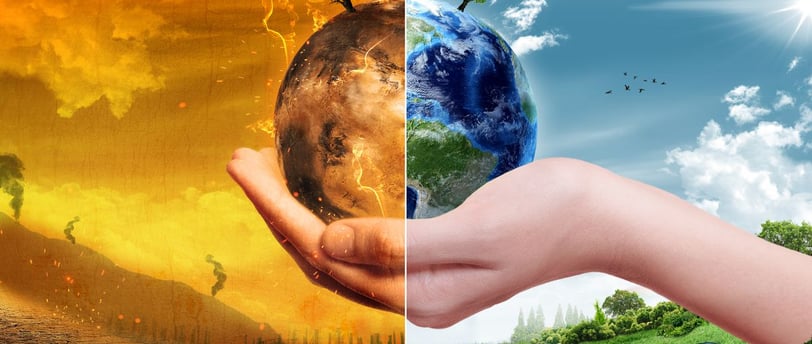OZONE DEPLETION: GREENHOUSE EFFECT: GLOBAL WARMING
Ozone Layer is a region in the earth’s stratosphere that contains high concentration of ozone and protects the earth from the harmful ultraviolet radiations of the sun
3/3/20243 min read


Ozone is a colourless gas produced by a re-combination of oxygen under the influence of ultra-violet radiations from the sun. The formation the ozone takes place in the upper layers of the atmosphere roughly around 16 km. The part of the stratosphere which is rich in ozone is known as the ozone layer or the ozone sphere.
Ozone layer acts as a protective umbrella around the earth. It absorbs the harmful ultra-violet radiations coming from the sun, and thus preventing it from reaching the earth. If all the ultra-violet radiations were to reach the earth’s surface, there would be no sign of human existence on the planet, it’s because of the protective layer formed by the ozone layer that the life on the earth is protected from the deadly ultra-violet rays. That is why the ozone layer is also known as the ozone umbrella. Also a main role is played by the ozone layer in controlling the temperature on the earth, wind pattern and rain.
However, in 1985, a famous scientist, Farman and his team discovered a hole in the ozone layer over Antarctica. This raise an alarm and the concern regarding environment issues and to control them has been focused upon. The main for the ozone hole are chlorofluorocarbons, carbon tetrachloride, methyl bromide and hydro chlorofluorocarbons.
What is ozone Layer Depletion?
The thinning of the ozone layer present in the upper atmosphere caused when the chlorine and bromine atoms in the atmosphere come in contact with ozone and destroy the ozone molecules is ozone depletion. Chlorofluorocarbons are the most abundant ozone-depleting substance.
The main effects of the depletion of the ozone layer are as under:
· An increase in ultra-violet radiation causes increase in skin cancer ailments.
· Ultra-violet radiations affect the human immune system making human beings more susceptible to various diseases.
· Growth of plants and their productivity is affects as ultra-violet radiation reduces the photosynthetic pigment.
· Excessive amount of ultra-violet radiation can kill several animal species, insects and plants, leading to imbalance in the eco-system.
GREENHOUSE EFFECT: GLOBAL WARMING
In the upper part of the atmosphere, there is a protective layer of ozone, likewise in the lower atmosphere, there is a similar layer of carbon dioxide. Whereas the harmful ultra-violet radiation is absorbed by the ozone layer, the infra-red rays pass through the layer of carbon dioxide and reach the surface of the earth. The Greenhouse effect keeps the Earth’s temperature warmer than it would otherwise be, supporting the life on earth. The thick layer of carbon dioxide in the atmosphere works like a glass panels of a greenhouse, which allows the sunlight to filter in but prevent the heat from escaping out of the greenhouse. This is why this phenomenon is called the “greenhouse effect.”
The greenhouse effect results in the generation of heat in the atmosphere which is necessary for the existence of life on the earth and without which the earth would have become a cold, lifeless planet. But when the concentration of carbon dioxide, methane and other gases reach an undesirably high level, it increases the temperature of the earth’s atmosphere which results in what is called as Global Warming.
Effects of Global Warming
· Global warming will cause ice bergs to melt, which would ultimately result in increasing the sea level due to which the coastal cities would get submerged in water.
· The rise in the sea level poses a serious threat to the coral reef eco-system.
· Rising temperature will deal a death blow to several forms of micro-organisms
· Global warming will also affect the wind patterns resulting in climate changes.
· Global warming will cause major changes in the water distribution adversely affecting the water resources and causing imbalance in water available to different countries.
· Rainfall pattern will also get affected and adversely agricultural input will be affected in various regions of the world.
· Global warming will have several socio-economic impacts such as climate changes, flooding, melting of ice bergs, landslides etc.
Therefore, it is necessary to take effective steps to reduce the emission of greenhouse gases so as to protect the earth and its atmosphere from global warming.
